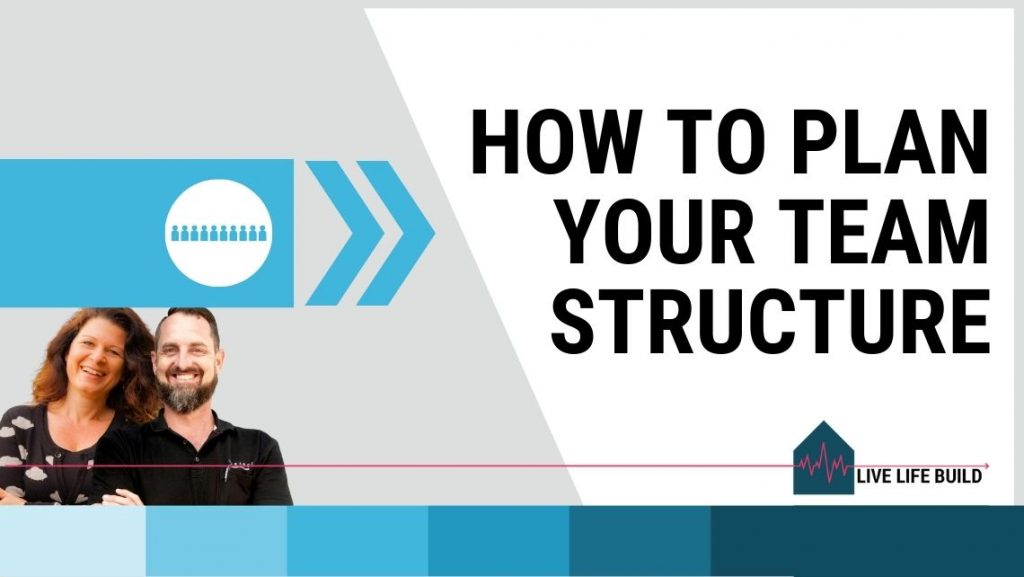How do you plan your team structure in a successful building business?
And stop wearing all the hats so you can free up your time and not be permanently tied to your building business?
In this blog, we take you through the 5, 4, 3, 2, 1 of Team Structure, and how to start planning for the future of your business.
And maybe, even get you off the tools!
Many builders will be desperate to simply find and hire people to do the work they hate doing, and not think about whether that’s the best option for their future team structure and business goals.
So, whether you’re still a sole operator, on the tools everyday and then making everything else happen after hours …
Or, you are building a small team already …
Check out our 5, 4, 3, 2, 1 of our 6P Methodology PEOPLE: Your Team Structure.
5. STOP WEARING ALL THE HATS IN YOUR BUSINESS
You may be well-trained in the skills of construction, but running a building business requires a lot of other skills. And, many builders (especially those early in their business journeys), wear all the hats needed to keep a business going.
So, what hats are these? There’s a LOT. From the administration of projects, to financial management of accounts, to relationships with clients and business colleagues, to strategic planning to marketing and networking to keep attracting new projects.
Of course, there can be issues with being this type of builder and business owner.
Even the most entrepreneurial of builders can struggle with strong abilities in all of these areas.
It takes a lot of effort and learning to master the specifics in each of these areas, and with the rate of change these days, staying on top of the latest technology and legislation can be super challenging.
Many builders feel they’re not in a position to afford outsourcing or hiring help in these other areas of their business. So they juggle it in the meantime (or rope a partner or wife into helping after hours).
However, you’re far better use to yourself and your business if you’re sticking to what you do well – or your ‘zone of genius’.
Doing a half-arsed job of all things will always kill a business far faster than investing in the right help, and freeing yourself up to focus on what you’re great at.

4. THINK FUTURE: YOUR IDEAL ROLE
Many builders believe that they’re best on the tools, doing the work they were trained to do.
However, if you plan to grow your business, someone needs to be driving strategic planning and working ON the business, rather than IN it all the time.
And frankly, you could probably replace yourself as a skilled contractor on your projects far more inexpensively, than you could source a CEO for your business.
Given the physicality of construction work, you may find it has an expiry date for you age-wise at some point in the future. And, if your business is relying on you to do all the physical work, and you get sick or injured, your business stops.
So, what do you enjoy doing? What are you good at? What would this look like in the future of your business?
If your business is still involving you doing everything, then think about the skills you’ve demonstrated in other parts of your life, or as you’ve grown up.
We find lots of builders were natural leaders as kids.
They played a lot of team sports, and enjoyed motivating others to achieve a collective goal.
Or they enjoyed tinkering, solving problems and finding new ways to get things done.
Or they were the entertainer in their group of friends, great at making people laugh and feel at ease, and get along well with each other.
These are AMAZING skills you can cultivate to improve your building business in your role as its owner.

3. PLAN YOUR FUTURE BUSINESS TEAM STRUCTURE
When thinking long-term about your business, think about the number of projects you’d like to be doing. What revenue total would that be? What might that mean in your team size?
Many builders scale too quickly, without understanding the true cost of running their existing business, let alone a bigger one.
And so, they get on a cashflow treadmill where they’re racing to keep getting jobs to fund the team (and machine) they’ve built to service it all.
Wrap your head around your existing business in detail first, knowing the true running costs, overheads and profit margins, and then use that information to plan your growth.
Then, think about the number of projects you’d like to do in the future (and perhaps that might be aligned with revenue goals or ideal team size or project types).
What does that mean for your team structure? How many administrative staff? How many in your project team? How would you be spending your time as the business owner on a daily basis?
When you spend some time mapping this out, putting cost estimates against salaries for those various new people and roles in your business, you’ll start to see the revenue you’ll be needing to cover a business of that size.
Plus who will be a project cost vs a business cost (or overhead).

2. DEFINE ROLES AND RESPONSIBILITIES
Perhaps you already have a team helping in your business. Or you’re keen to start building one. Either way, it’s important to carefully define the roles and responsibilities of each team member.
Many builders we know have high expectations of themselves … and are also control freaks, liking things to be done a specific way, and think they’re the only one who can do it that way.
However, whilst you’re the one doing all.the.things, you’ll always be tied to your business. And didn’t you start a business to actually have more freedom and autonomy with your time?
Having role descriptions may seem very corporate, but it’s so worthwhile for giving a clear outline that helps team members understand exactly what you expect from them, and how to fulfill those expectations.
It also gives you a place to return to when you need to give feedback, or performance-manage any issues.
Role descriptions can outline:
- Title of role
- Who that role reports to (as in, who manages them)
- Specific tasks of that role
- Expected hours associated with the role
- Any unique responsibilities associated with the role
- KPIs or Key Performance Indicators for the role (this needs to be something measurable, and the more objective it can be, the simpler it is to identify if it’s being achieved)
You might also like to include some fun or meaningful things associated with your business values and culture.
Some great examples we’ve seen identify things like “the top 3 things you can do to make us think you’re amazing” and “the 3 things you can do that will completely frustrate us”.

1. EXECUTE IT WELL
If you’ve not managed people before, it can be challenging to start. It’s not always that comes naturally, and can require upskilling to do it well.
Plus, it also requires you to consider your own performance. People will follow what you do far more than they’ll follow what you say.
You set the culture and performance standards for your own business, and so if your behaviour is different to what you say you expect of others, you’ll be dealing with team problems from the get-go.
You get to grow your business exactly how you want to. With all the ‘million dollar builder’ claptrap around, many builders feel they have to chase revenue and getting bigger as a measure of being successful.
But, like we said earlier, a business won’t become more profitable just because it’s bigger.
In fact, you can find that growing an unprofitable business just makes your headaches MUCH bigger, and puts a lot more on the line in your personal finances. Builders go out the back door very quickly doing this.
We’ve seen lots of builders previously celebrated for having high revenue businesses that went bankrupt, left homeowners and subcontractors seriously out of pocket, and are now teaching others how to grow their business. Frankly, it’s insane.
One of our Life Life Build members experienced this.
He grew too fast. He didn’t have his finances, his understanding of overheads and business running costs in hand, and expanded his teams and projects quickly. It all caught up with him, and he was advised to go into bankruptcy to get out of it.
Admirably, and amazingly, he instead has traded his way out of it. He’s had a tough period doing so, and it’s taken time – but he’s honoured his commitment to those he owed money to, and made it work. And now he’s growing his business far more sustainably, identifying the business he REALLY wants to have – rather than what others tell him success looks like.
Don’t get sucked into the hustle sold to you by builders who have no clue what it’s actually costing them to run their business … or worse, have never worked as builders themselves.
It’s why we’re so passionate at Live Life Build to help builders from where we are: business owners ourselves, in this industry, having first-hand experience in working with clients, managing teams and making projects happen.

So, here’s our 5, 4, 3, 2, 1 on your Team Structure, from our 6P Methodology for PEOPLE:
5. Stop wearing all the hats in your business.
4. Think future: your ideal role.
3. Plan your business’ future team structure.
2. Define roles and responsibilities.
1. Execute it well.
Live Life Build’s 6P Methodology unlocks the 6 ways to elevate your building business:
PERSONAL | PROJECTS | PEOPLE | PARTNERSHIPS | PROCESSES | PROFESSIONAL
So, what are you doing to create the right team structure for long term performance and sustainability in your building business?

